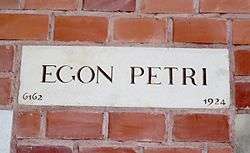Egon Petri


Egon Petri (23 March 1881 – 27 May 1962) was a classical pianist.
Life and career
Petri's family was Dutch and he was born a Dutch citizen, but he was born in Hanover in Germany and was brought up in Dresden, where he attended the Kreuzschule. His father was a professional violinist who taught his son that instrument. Petri played in the Dresden Court Orchestra and with his father's string quartet while still a teenager. He studied composition and theory with Hermann Kretzschmar and Felix Draeseke at the Dresden Conservatory.
From an early age, Petri had also taken piano lessons and he eventually concentrated on that instrument, after strong encouragement from Ignacy Jan Paderewski and Ferruccio Busoni. He studied with Busoni, who proved to be a great influence on him. He considered himself more of a disciple of Busoni's than his student. Thanks to Busoni, Petri focused on the works of Johann Sebastian Bach and Franz Liszt, composers that, along with Busoni himself, remained at the centre of his repertoire.
Petri moved with Busoni to Switzerland during World War I where he assisted him in editing Bach's keyboard works. In the 1920s, Petri taught in Berlin; Victor Borge, Stanley Gardner, Jan Hoffman, Gunnar Johansen and Vitya Vronsky being among his students. In 1923 he became the first non-Soviet soloist to play in the Soviet Union. In 1927 he moved to Zakopane in Poland where he conducted summer and early fall sessions and master-classes to a group of pre-selected piano students until the outbreak of World War II in 1939. From 1929, he made a number of recordings for several labels including Columbia Records.
Petri escaped Poland the day before the German invasion in September 1939, but he had to leave behind all his books, music and letters, including his correspondence with Busoni (these papers survived and have been recovered). He moved to the United States, working first at Cornell University and later at Mills College in Oakland, California. He pointedly refused ever to play in Germany again. He became a naturalised American citizen in 1955.
Although a Dutch citizen until he was 74, he never lived in the Netherlands and was not at ease with the Dutch language. On one occasion he performed for Queen Wilhelmina, but they spoke in German. He was fluent in German, English, French, Italian, Polish and Russian.
He was an influential figure among many pianists of the middle 20th century. Earl Wild, Ozan Marsh and John Ogdon were among his international students. A big man, Petri had a superb technique and a powerful sonority, and was a superlative exponent of the larger works of Beethoven, Liszt and Brahms.[1] He was also a proponent of new music.
Petri died in 1962 in Berkeley, California.
Students
References
- ↑ Schonberg, Harold C. (1987). The Great Pianists from Mozart to the Present, Second Edition, New York: Simon & Schuster. ISBN 0-671-64200-6.